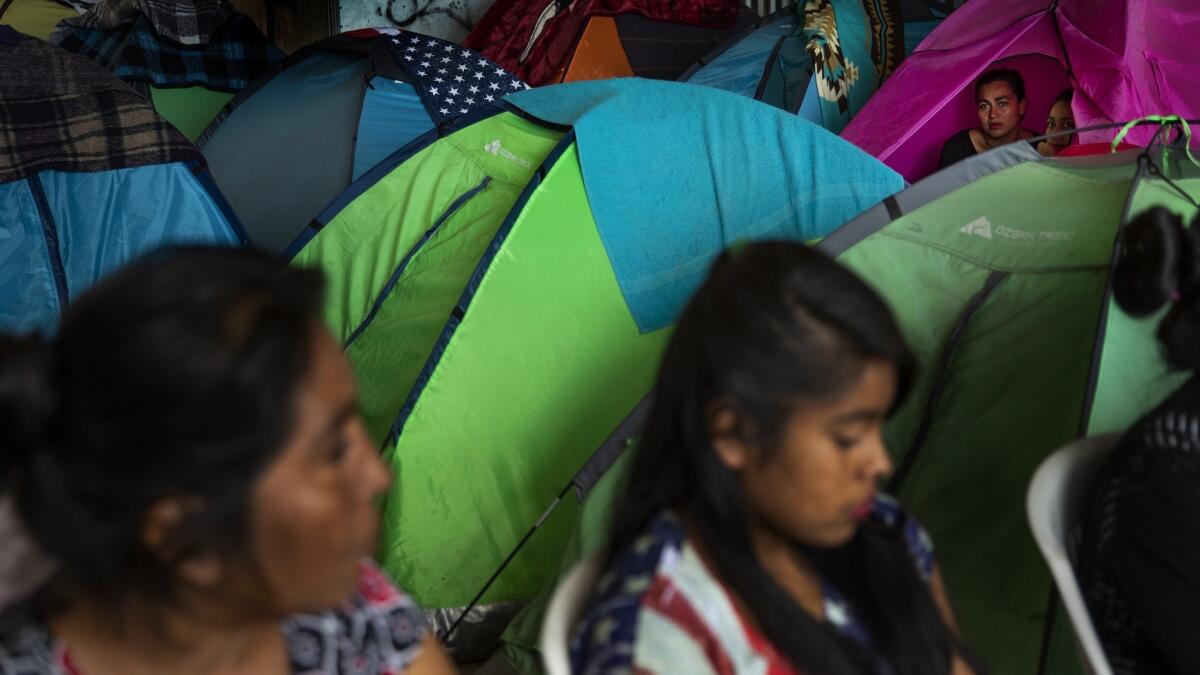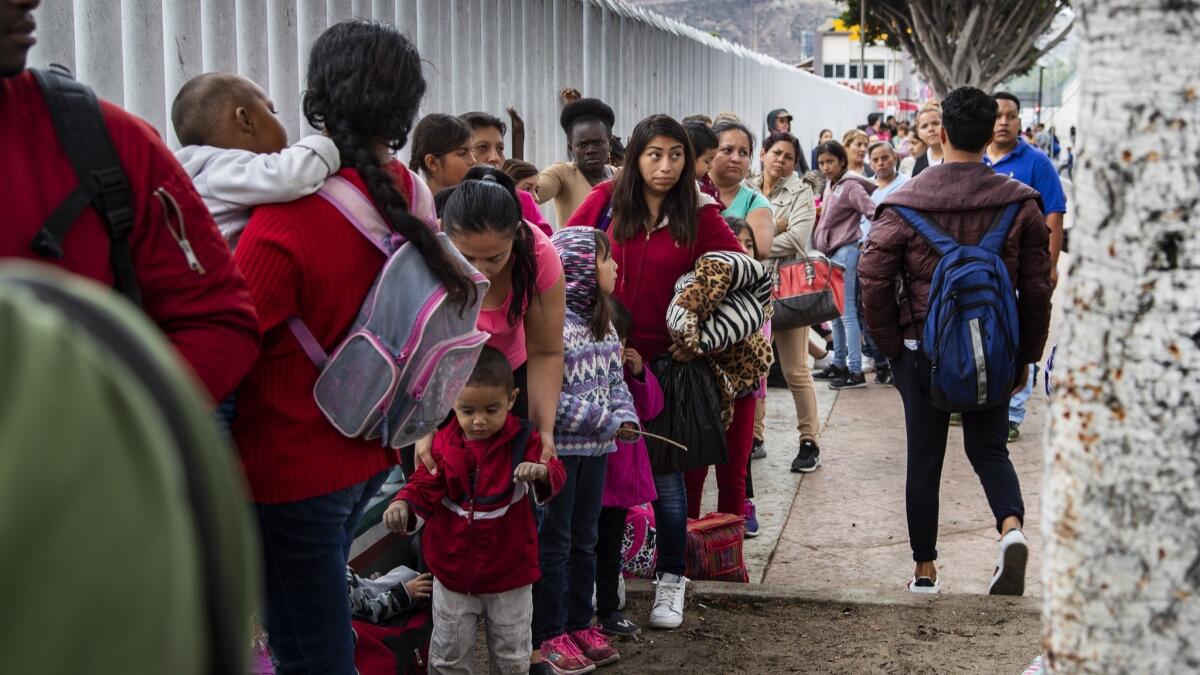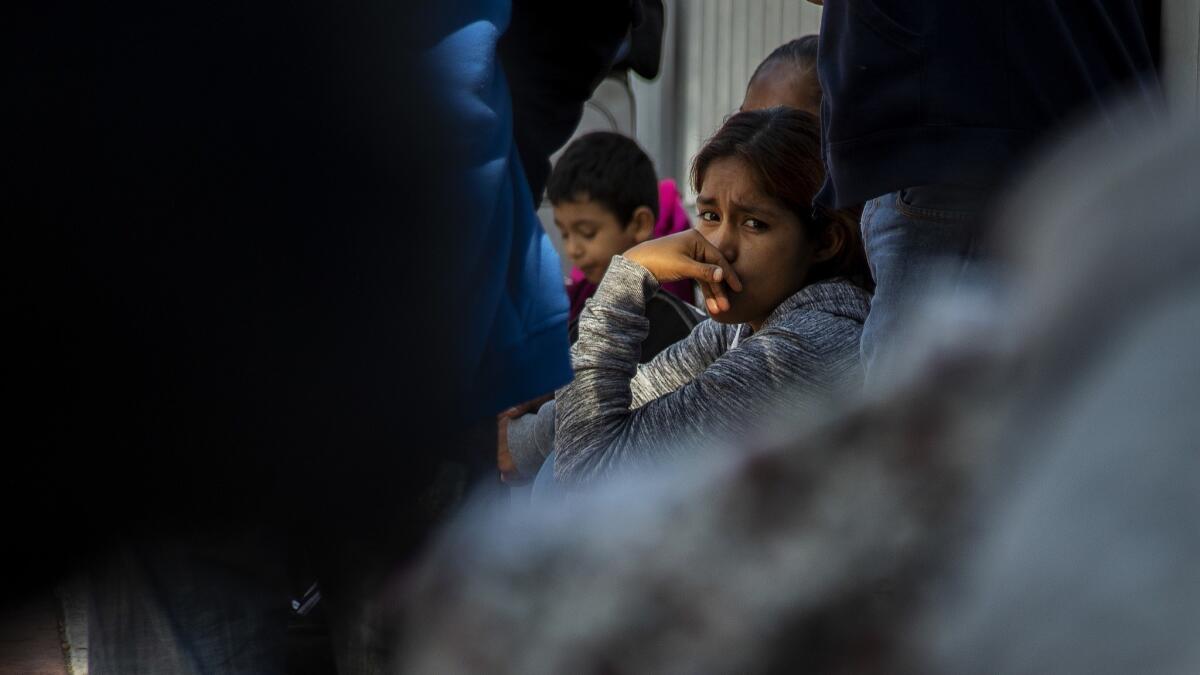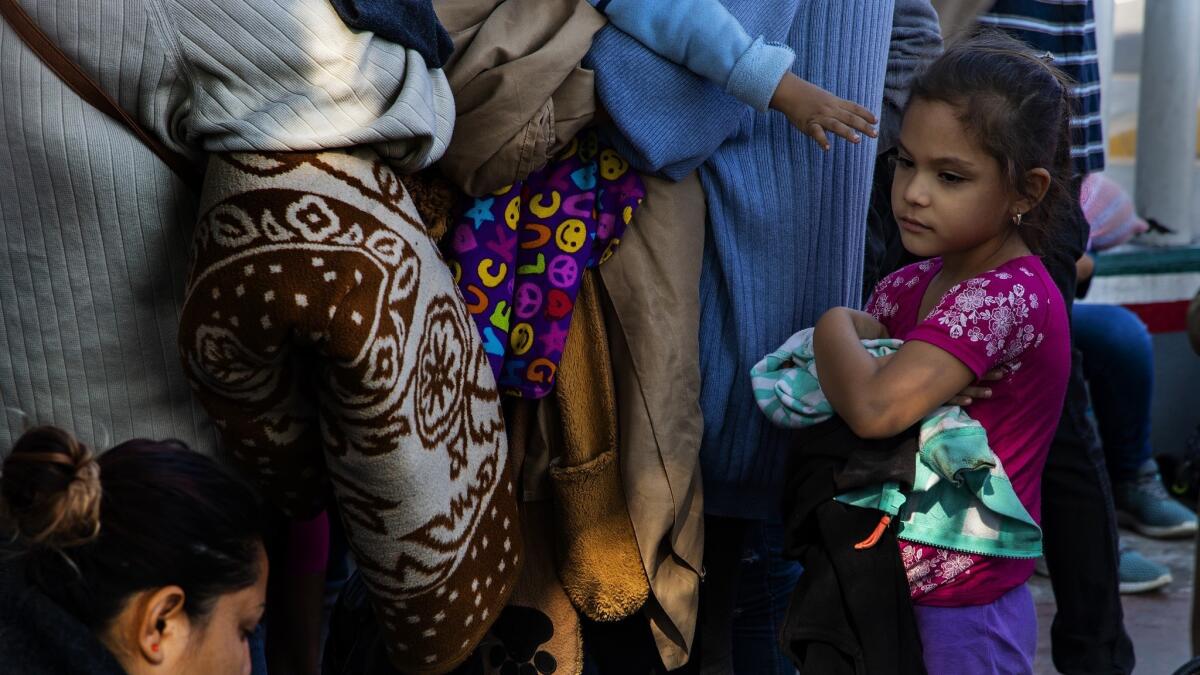Must Reads: For many waiting in Tijuana, a mysterious notebook is the key to seeking asylum
- Share via
Reporting from Tijuana — All conversations stopped when they saw the notebook.
Men, women and children — asylum seekers from Central America, Mexico, Africa and beyond — parted to make way for its keeper.
The Mexican woman named Gaby waded through the crowd. She clutched the ledger-like notebook, its spine reinforced with duct tape.
Mothers scooped up their toddlers. Older children dropped their toys. Fathers hushed infants.
The notebook holds the names of hundreds of asylum seekers — from Guadalajara to Ghana — all trying to make their case at the San Ysidro Port of Entry.
It is an improvised response, an attempt to inject order into chaos. Getting in the notebook is paramount. For the desperate foreigners whose future hinges on it, the stakes are high.
Nearly 2,000 people seeking asylum in the United States have put their name in the notebook. Its origins are unclear, but it was created after U.S. border officials began to limit the number of asylum seekers allowed to enter the San Ysidro Port of Entry.
The notebook became a way for the immigrants to keep track of who is next in line. The book’s guardian — always an asylum seeker — scrawls each person’s name and country of origin in blue ink. The names of those who already entered the port of entry to make their case for refuge are highlighted in yellow or pink.
On this day, the crowd clamored for information. The notebook held answers: How many people were ahead ? How many people were let in the day before? How much longer would they have to wait?
People reached for the notebook as if it were a sacred totem. They stretched their necks to catch a glimpse. A few women in the crowd broke the silence, bombarding Gaby with questions. With caked-on makeup and drawn-on eyebrows, Gaby cut an imperious figure. She pursed her lips and hugged the notebook to her chest. She demanded silence.
A man in the back yelled out in Spanish: “Quiet, please! This way everyone can have a chance to hear what she says.”
The notebook is supposed to be impartial. But there are doubts about that.
Some immigrants believe that it is colored by prejudices, favoritism and sometimes corruption. Whoever holds it wields power. Their position is temporary. They are eager to cross too.

The notebook has become an added layer of unsanctioned bureaucracy that asylum seekers encounter when they first arrive. U.S. border officials refuse to comment on it. But getting one’s name in the notebook has become a crucial step to make it through America’s doors.
A month ago, Rafael Castillo Ochoa, a 44-year-old farmer, fled Michoacán with his wife and three children after drug cartel gunmen killed his brothers.
“The notebook is the key to enter the United States,” he said. “It holds our future, a better future for our children.”
Once the crowd became silent, Gaby read out the names of the 30 people who were next on the list to give themselves up to U.S. border officials at the San Ysidro Port of Entry for a chance at asylum. Most were Central American mothers with small children.
“The list is literally just at the whim of one person who has no accountability. There is no oversight,” said Alex Mensing, an organizer with Pueblo Sin Fronteras, an immigrant advocacy organization that accompanied a Central American caravan earlier this spring to the port of entry. “This is just destined to create more tension and trauma.”
About two years ago, U.S. Customs and Border Protection began to limit the number of asylum seekers allowed to enter per day. Agency officials contend that the San Ysidro Port of Entry — the busiest land border crossing in the Western Hemisphere — does not have the capacity to process everyone at once.
“Depending upon port circumstances at the time of arrival, individuals presenting without documents may need to wait in Mexico as CBP officers work to process those already within our facilities,” an agency spokesman said.
As a result, the asylum seekers have been left to camp out near the U.S.-Mexico border. Sometimes they linger for up to a month in more than two dozen temporary shelters in Tijuana. With the help of Mexican immigration officials, the asylum seekers adopted the notebook.
It was after 9 a.m. on a recent Thursday, and Gaby had arrived late. Most in the group had waited anxiously at the port of entry for two hours.
“Number 204. Gustavo Adolfo?” she read out loud from the list.
Others in the group echoed her, carrying the name to the back of the crowd like a pail of water.
“Presente!” the man called out.
The names Gaby read from the list had been called out a few days back. They hadn’t shown up. She was giving them a second chance. Some thought that wasn’t fair.
“If we keep going at this rate, we won’t advance,” muttered a Salvadoran woman, carrying an infant.
In the crowd, a Honduran woman perched against her roller bag spoke into her cellphone with a family member back home. Her name had been called but she worried that she wouldn’t be able to make it to her destination in the U.S. even if she were let in.
“I don’t have enough money to make it to Miami,” she said into the phone. “Can you send it to me?”
“Go with God,” a woman shouted at the group that got called.
The chosen ones walked toward a man in an orange-colored sweater — a representative of Grupos Beta, the humanitarian arm of Mexican immigration services. The man, who gave his name only as Sergio, told the group to walk toward a white gate near a parking lot. Next to it, a pedestrian bridge led to the U.S. port of entry.
A 14-year-old boy dragged a baby blue vintage bag. Mothers smiled nervously. A father whispered in his toddler’s ear, begging her to stop wiggling and stay in his arms.
“Get in a straight line. Scoot back some more. Hurry up,” Sergio said, like a drill sergeant.

A diminutive woman from Guatemala tugged on Sergio’s sweater, telling him she’d just arrived and wanted to seek asylum.
“You need to get your name on that list,” he told her, motioning toward Gaby and the notebook.
At 9:39 a.m., Gaby closed the book. The Guatemalan woman grabbed her torn luggage and ran toward a group that followed her. They resembled an entourage, sprinkling her with questions.
“Can I get my name on that list?” the Guatemalan woman asked Gaby.
“How much longer do you think I’ll have to wait?” another woman wondered aloud.
Gaby reopened her book. A man from Ghana approached her.
“My number is not even in the notebook,” he told her in broken Spanish. “What happened to the other book? Why was I not called?”
Gaby shrugged and explained that she had just taken responsibility of the list. She didn’t know anything about the prior notebook. The last person in charge — a man by the name of Manuel — had entered the port of entry a few days back, she told him.
“I’m in charge of the notebook now,” she declared. “Before I turn myself in to ask for asylum, I will choose someone who I believe is responsible enough to take over the notebook. I will choose.”
The man from Ghana took up Gaby on her offer to include him at the very end of the notebook.
Defeated, he walked back to a group of African asylum seekers who leaned against a white gate. Just feet away, Haitians spoke in French. Near the main entrance to the port of entry, the Central Americans and Mexicans milled about.
It’s unclear why the man from Ghana was left out of the former notebook. But organizations monitoring the situation say the notebook has led to instances of discrimination against asylum seekers who are transgender, gay or African.
“People bring their own prejudices to the list making” said Nicole Ramos, the refugee program director for Al Otro Lado, a binational organization that offers legal services to deportees and migrants in Tijuana.
Who first created the list is a bit of a mystery.

In the spring of 2016, the U.S. and Mexican governments developed a metering system to manage an increased flow of asylum seekers at the San Ysidro Port of Entry. Hundreds of people camped outside the port’s pedestrian bridge. With the consent of U.S. border officials, Grupos Beta began to hand out appointment dates with agency officials. Asylum seekers without appointments were turned away.
It all came to a stop when Al Otro Lado launched a lawsuit against the U.S. government, stating that top officials had violated provisions in the U.S. Immigration Nationality Act. The law states that any foreigner who reaches the U.S. has the right to apply for asylum. The suit also contends that the U.S. government is violating international law and the rights of due process for asylum seekers.
Immigration lawyers and advocates contend that the notebook solution that arose is illegal.
The notebook is a way for Grupos Beta to insulate itself from liability, Ramos said.
“People should know that they could really go to the port of entry without having to deal with an in-between person,” she said. “The only reason they engage with the list is because they feel they have no other choice.”
When asked about the notebook, Sergio of Grupos Beta said he had no control over it.
“They handle it all themselves,” he said and pointed at the crowd before him.
A representative with Grupos Beta, who didn’t want to be identified, laid out the process:
Before nightfall, the notebook’s keeper hands off the notebook to a representative with Grupos Beta. The notebook is kept in a safe in an undisclosed location. The next morning, the notebook manager returns to the port of entry and retrieves the notebook from Grupos Beta. At some point, border officials tell Grupos Beta how many people they will process that day. That information is given to the book’s guardian, who calls out the names.
With her number about to come up, Gaby eventually passed the notebook to Jose Cortes, a single dad from El Salvador who had fled gang violence with his 4-year-old daughter.
Cortes, who wore his daughter’s pink Minnie Mouse backpack, arrived earlier in the morning — much earlier than Gaby ever did, most noted.
Where Gaby was terse, Cortes was willing to share more information. At one point, he offered his cellphone number to anyone who asked.
But by mid-morning he appeared overwhelmed as he stood on a small ledge on the sidewalk and asked for everyone to listen.
“We should all accept to get here earlier in the day so we don’t get behind in the list,” Cortes said. “We are no longer going to go backward in the list. If you aren’t here when your number is called, you stay behind. For instance, if my number is called and I’m not here, I stay behind. I want everyone to be conscious of that.”
As Cortes fielded questions, his daughter pulled on his shirt.
“Papa. I’m hungry,” she told him. “Can we get something to eat, please?”
He brushed her off, asking her to wait a bit more.
“This is a lot,” he told the women asking him questions. “It’s harder than I thought it would be.”
Jamileth Alonzo, of Honduras, did not care for the notebook.
“It’s just a complete disorder, that list,” she said.
The 40-year-old was one of the asylum seekers who showed up late and missed her chance to enter. For days, she’d arrived early only to wait hours for Gaby, she said.
She had grown weary of being at the mercy of the notebook — and the person who wielded it.

Follow Cindy Carcamo on Twitter @thecindycarcamo
More to Read
Sign up for Essential California
The most important California stories and recommendations in your inbox every morning.
You may occasionally receive promotional content from the Los Angeles Times.














